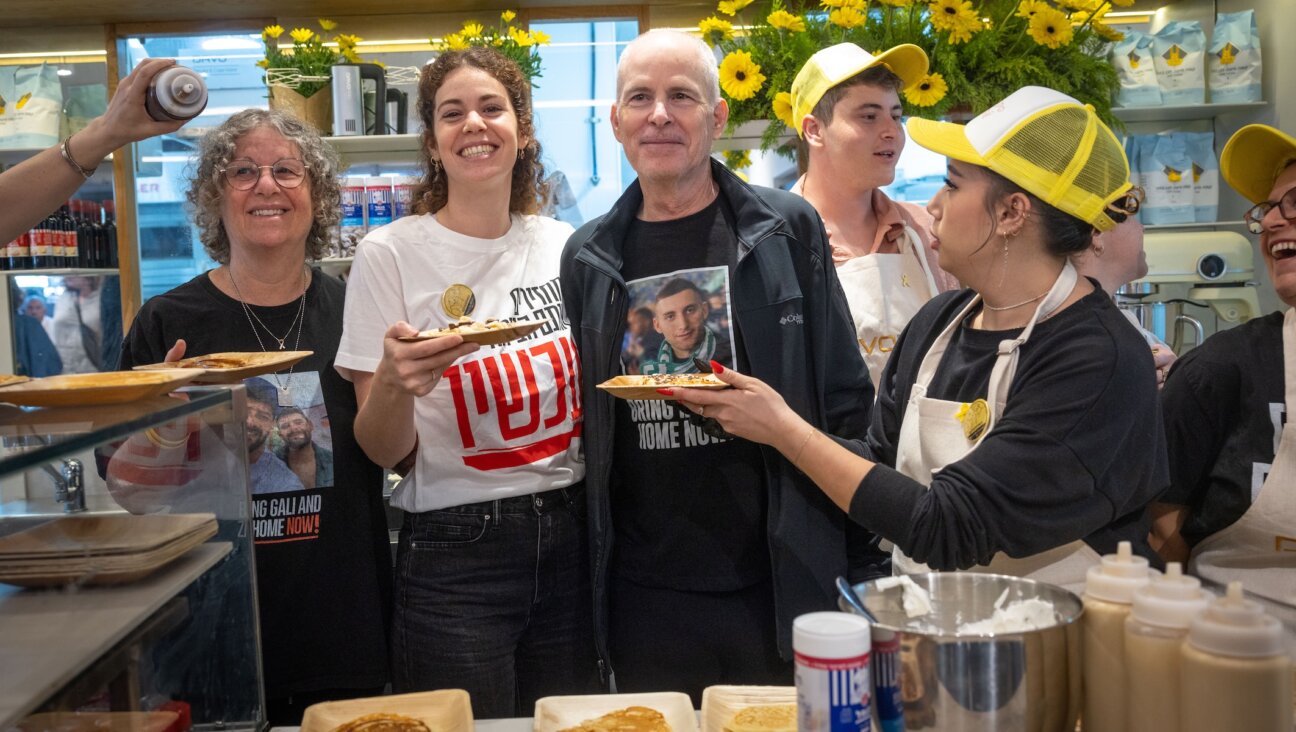Tasty Treats Few and Far Between at Kosherfest
Far from being a fringe movement, kosher food is becoming as American as (non-meat) hot dogs and (nondairy) apple pie — a point that was driven home last month at the 2003 Kosherfest food trade show, held in New York’s Jacob Javits Convention Center.
According to statistics compiled by the marketing firm IMC Events and Exhibitions, sales of kosher foods rose 15% in America in 2002, to a total of $6.75 billion. Some 75,000 kosher-certified products are now on the market, a number that grows by about 3,000 every year.
What’s especially interesting about the expansion of the kosher market in recent years is how few of its consumers — less than 10% — are Jews who keep kosher year-round (half as many are Muslims who observe halal dietary requirements, which are much like those of kashrut). The greater majority of Americans who seek out kosher products do so because they believe that the products are healthier or better tasting. Neither of these attributes, it must be said, was much in evidence at this year’s Kosherfest.
It is clear that the central priority of Kosherfest’s organizers was to demonstrate the ever-growing bounty of kosher food (Kosherfest’s promotional material makes sure to note how each year’s convention is bigger than the previous one), and as a result no discrimination seems to have been exercised in the realm of quality control. Any company, it seems, was free to display its wares, as long as those wares happen to carry kosher certification. The 275 exhibitors at the convention hawked everything from kosher breath strips to kosher teeth whiteners, bottles of kosher Omega-3 fish oil dietary supplement to cans of kosher dog food, which is made without bread fillers so that it can be kept in the house during Passover. The vast majority of Kosherfest’s exhibitors, though, are purveyors of pre-cooked packaged foods designed to satisfy the most powerful craving of the modern consumer: convenience. So visitors were met with booth after booth displaying such items as frozen pizza, frozen pasta, frozen enchiladas, frozen latke batter, heat-and-serve dinners, fish sticks, mozzarella sticks, cookie mixes, microwave onion rings, flavored tortilla chips and flavored popcorn.
At Kosherfest the word “gourmet” was trumpeted everywhere, reminding one of used-car dealers prefacing their name with the appellation “honest.” With few exceptions, the convention was like a vast theme park of bad food: sour dips, rubbery cheeses, soggy pretzels, gummy cookies, astringent wines. Fairly representative were the so-called french-toast sticks (“fun for the whole family”) made by the Spring Valley company. The sticks emerge from the microwave with a chewy, sponge-like consistency and an oddly indeterminate taste, the vague presence of cinnamon hovering somewhere in the background. Not surprisingly, the product has one of those 2-inch-long ingredients lists, many of them of the laboratory-fabricated variety.
Fortunately, the kosher industry is also making some food that doesn’t taste industrial. The best products exhibited at this year’s Kosherfest came not from the corporate behemoths like Campbell’s or Kellogg’s, which certify their products in order to expand their consumer base; nor from the kosher-specific companies turning out ill-conceived renditions of mass-market American foods. Rather, they come from smaller companies focusing on a limited line of products that don’t have to be altered radically to be made kosher. This is being done especially well with sauces, dressings and marinades.
Among the better ones exhibited at this year’s Kosherfest were a pleasingly sweet Vidalia Onion salad dressing from Golding Farms of North Carolina and the Bone Suckin’ barbecue sauce made by another North Carolina company, Ford’s Foods. Not overly spicy, this is a western North Carolina-style tomato-based sauce (the eastern version has a vinegar base, and no tomatoes), with a pleasingly smoky, sweet-and-sour backdrop of honey and mustard. For a very different sort of sauce, intended for fish rather than meat, there’s the wasabi sauce introduced this year by Gold’s, the venerable producer of excellent prepared horseradish. Wasabi, the traditional accompaniment to sushi, might seem an unlikely stretch for a Jewish family from Long Island, but not really — the wasabi root is related to the horseradish root, and in fact is sometimes referred to as “Japanese horseradish.” Gold’s wasabi sauce, though not as mouth-tingly, sinus-clearingly potent as the wasabi paste served in most Japanese restaurants, is nonetheless pungent and full flavored, and would be perfect with a rich, oily fish such as salmon or tuna.
Many of Kosherfest’s exhibitors would have you believe that their products taste like your grandmother’s did; this is almost always a false claim (unless your grandmother happened to be a really terrible cook), except in the case of the San Francisco-based company Bubbies. Bubbies is the brainchild of John and Kathy Gray (Kathy’s Polish-born grandmother, Mary Levi, who provided many of the company’s recipes, is the eponymous bubbe), a married couple who one day decided that they had had enough of the world of banking and wanted to go into food manufacturing.
Happily enough, they chose to focus their attention on pickles and other preserved foods, all of which are made without resort to artificial preservatives. I love Bubbies’ dill pickles, but I’m especially mad for the bread-and-butter pickles — thinly sliced sweet pickles, fermented with vinegar, sugar and sweet spices. If you’ve never had bread-and-butter pickles, you won’t find a better place to start than with Bubbies’, which are sweet and tangy and have the kind of crispness that has long since disappeared from jarred pickles. These are simply the best pickles you’ll find outside of a barrel. Bubbies also makes very good sauerkraut and horseradish, but among their non-pickle products, my favorite may well be the herring in cream sauce. This is a notoriously difficult food to mass produce, one that other national companies invariably get wrong, but Bubbies manages it flawlessly: The herring is unmistakably fresh and clean tasting, and the sauce is thick and smooth, with a beautifully rounded flavor. As with Bubbies’ pickles, this is the best jarred herring available anywhere. (Bubbies products are available in natural foods stores or online at www.bubbies.com.)
Like Bubbies, Wild Thymes is a family enterprise, started by an urban couple seeking a lifestyle change. Back in the 1970s, Manhattanites Enid and Fred Stettner left the city for a 400-acre farm in upstate New York’s Hudson Valley. Today, Enid and her daughter Ann oversee Wild Thymes, which produces a wide range of all-natural specialty foods, including chutneys, fruit spreads, sauces, vinaigrettes, mustards and pasta toppings. Even with such a diverse line, the Stettners have not forsaken quality control, as they make all their products by hand, in small batches, right on their family farm. These foods actually taste like the ingredients featured on the label, be it the mango in the mango vinaigrette or the raspberries in the raspberry lemon fruit spread. I especially like the cranberry sauce: just the right balance of sweet and tart, enlivened with lemon and orange, with soft whole cranberries adding a bit of extra texture. I also love the rich, dark plum currant ginger chutney, perfect as an accompaniment to Indian food or — why not? — spooned over potato latkes. (Wild Thymes products are available nationwide in specialty and natural foods stores, or online at www.wildthymes.com.)
Bubbies and Wild Thymes offer consumers products that are thoughtfully conceived, carefully made and reliably delicious. As such, they provide a much-needed counterpoint to Kosherfest’s triumphalist manifesto: Those who keep kosher can now be just as unhealthy as anyone else in America, and eat just as poorly.
The Forward is free to read, but it isn’t free to produce

I hope you appreciated this article. Before you go, I’d like to ask you to please support the Forward.
At a time when other newsrooms are closing or cutting back, the Forward has removed its paywall and invested additional resources to report on the ground from Israel and around the U.S. on the impact of the war, rising antisemitism and polarized discourse.
Readers like you make it all possible. We’ve started our Passover Fundraising Drive, and we need 1,800 readers like you to step up to support the Forward by April 21. Members of the Forward board are even matching the first 1,000 gifts, up to $70,000.
This is a great time to support independent Jewish journalism, because every dollar goes twice as far.
— Rachel Fishman Feddersen, Publisher and CEO
2X match on all Passover gifts!
Most Popular
- 1

Film & TV What Gal Gadot has said about the Israeli-Palestinian conflict
- 2

News A Jewish Republican and Muslim Democrat are suddenly in a tight race for a special seat in Congress
- 3

Culture How two Jewish names — Kohen and Mira — are dividing red and blue states
- 4

Opinion Is this new documentary giving voice to American Jewish anguish — or simply stoking fear?
In Case You Missed It
-

Fast Forward Trump’s plan to enlist Elon Musk began at Lubavitcher Rebbe’s grave
-

Film & TV In this Jewish family, everybody needs therapy — especially the therapists themselves
-

Fast Forward Katrina Armstrong steps down as Columbia president after White House pressure over antisemitism
-

Yiddish אַ בליק צוריק אויף די פֿאָרווערטס־רעקלאַמעס פֿאַר פּסח A look back at the Forward ads for Passover products
קאָקאַ־קאָלאַ“, „מאַקסוועל האַוז“ און אַנדערע גרויסע פֿירמעס האָבן דעמאָלט רעקלאַמירט אינעם פֿאָרווערטס
-
Shop the Forward Store
100% of profits support our journalism
Republish This Story
Please read before republishing
We’re happy to make this story available to republish for free, unless it originated with JTA, Haaretz or another publication (as indicated on the article) and as long as you follow our guidelines.
You must comply with the following:
- Credit the Forward
- Retain our pixel
- Preserve our canonical link in Google search
- Add a noindex tag in Google search
See our full guidelines for more information, and this guide for detail about canonical URLs.
To republish, copy the HTML by clicking on the yellow button to the right; it includes our tracking pixel, all paragraph styles and hyperlinks, the author byline and credit to the Forward. It does not include images; to avoid copyright violations, you must add them manually, following our guidelines. Please email us at [email protected], subject line “republish,” with any questions or to let us know what stories you’re picking up.














